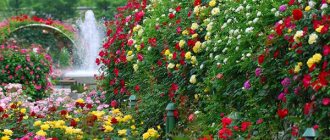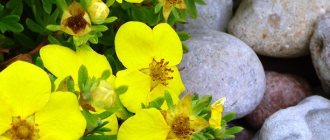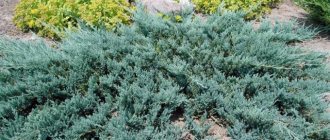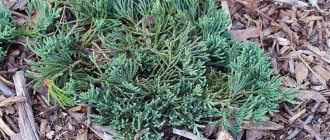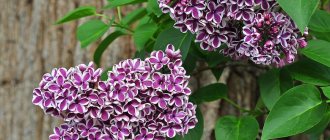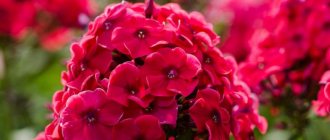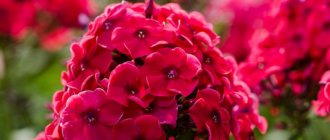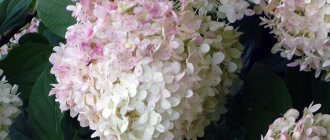Bushes and trees
0
553
Article rating
Kira Stoletova
Creeping or creeping juniper is a spectacular low-growing plant, popular in landscape design. Its varieties are of North American or Canadian origin. Thanks to its high resistance to cold and unpretentiousness, this conifer has become a favorite of gardeners - both experienced and beginners.
Creeping juniper: popular varieties
Popular varieties
Creeping juniper is represented by a large number of varieties that differ in size, shades and crown shape.
- Green Carpet is a lush classic juniper with a cushion-shaped crown reminiscent of a fluffy carpet;
- Blue Chip is a plant of a bright blue hue, with prickly needles and spectacular branches that form a “star”;
- Andorra Variegata is an interesting round variety with creamy flecks;
- Wiltoni is an original variety with obliquely growing, dense, bluish-silver shoots;
- Golden Carpet - distinguished by the golden color of young growth, which looks doubly impressive in combination with old greenish needles;
- Blue Forest is a plant with short skeletal branches, shaped like a miniature spruce forest.
Based on the color of the needles, most of them can be divided into green, blue and golden.
Some varieties change color by winter, for example, turning purple.
Varieties
About 60 varieties of horizontal juniper are known. Externally, the plants are very similar to each other. Gardeners even graft some creeping junipers onto a low stem. We present photos of the most common varieties of creeping juniper:
- Agnieszka;
- Andorra Variegata;
- Bar Harbor;
- Douglasii;
- Gray Pearl;
- Hughes;
- Ice Blue;
- Limeglow;
- Plumosa;
- Prince of Wales;
- Andorra Compact;
- Blue Chip;
- creeping blue juniper Blue Forest;
- Golden Carpet;
- Wiltoni.
Description of the plant
This type of juniper is also called “creeping”, “prostrate”, “ground cover”, “horizontal”.
The branches of the plant spread along the ground, creating a continuous carpet, which is a valuable property for landscape design.
The bushes reach a height of 10 to 50 cm, and a width of up to 1-2 m. The shape of the crown can be cushion-shaped, round or spreading.
The branches are covered with needles - scales or needles. The length of the needles is usually 2-5 mm. The color comes in various shades of green, gold, silver and blue.
The fruits are round cones, most often dark blue in color with a bluish coating. The root system is superficial and well branched.
Growing regions
This species is highly resistant to cold. All varieties are suitable for cultivation in central Russia (Black Earth, Central, North-Western and Volga regions).
Many frost-resistant varieties thrive in Siberia and the Urals. In the southern regions, it is recommended to shade young plants from sunburn.
The best types and varieties
The diversity of species, amazing plasticity, ability to withstand heavy pruning, versatility of use in landscaping, sustainability and ease of cultivation have become the reasons for the unprecedented popularity of junipers and prompted breeders to develop remarkable varieties and hybrid forms.
For information on how to plant, grow and properly care for juniper, read the article “Juniper - planting and care.”
Common juniper (Juniperus communis)
A spreading shrub or large tree, reaching a height of 10 m, pyramidal, spreading or creeping shape with narrow prickly needles and reddish-brown bark. Depending on the type of development and appearance, there are quite a few forms and variations, in particular, the following are popular:
- suecica – the crown is formed in the form of a wide column, the ends of the shoots hang down;
- compressa – up to 1 m high, narrow, columnar crown;
- pendula – spreading with a weeping crown;
- hibernica – slender, columnar, branches directed upwards.
The species is resistant to dust and air pollution and is successfully grown in urban environments. Grows well on poor sandy and rocky soils. More than a hundred varieties have been bred, and wild varieties are also attractive.
Green Carpet
Common juniper variety Green Carpet
The creeping, low-growing variety was obtained from a shrub discovered on the Norwegian coast at the end of the last century. The shoots and branches are directed horizontally, the crown is dense, and generally looks round. An adult plant reaches 15–30 cm in height, growing in diameter to 1.5–2.0 m.
The emerald, bright needles acquire a rich green color over time. Development is slow, the variety works well as a ground cover plant, and sparse partial shade is acceptable when placed.
Gold Cone
Common juniper variety Gold Cone
A spectacular German variety with a crown in the form of a narrow column or pyramid. It grows up to 2–3 m in height and up to 60 cm in width, develops quickly, and gives growth of up to 15–20 cm per year. The branches are directed obliquely upward, the ends of the shoots puff up, making the plant look slightly disheveled, which gives it charm.
In spring and early summer, the ends of the shoots turn yellowish, later the needles turn green, and in winter they acquire a creamy-brown tint. The variety gives plantings a sunny accent and is successfully used to create groups on the lawn, design rockeries and paths.
Sentinel or Pencil Point
Common juniper variety Sentinel
A stunning variety of Canadian selection with a narrow columnar or pyramidal crown resembles a thin pencil, the similarity is enhanced by the pointed tip. A ten-year-old tree reaches a height of 1.5 m and a diameter of about 30 cm. Due to the branches pressed to the trunk and directed upward, the crown looks molded and even.
Small needle-shaped needles of rich green color or with a slight bluish tint are not inclined to turn brown in winter. Sentinel looks great as a tapeworm near rocky hills, near lush conifers, or when planted in groups of three plants.
Cossack juniper (Juniperus sabina)
The robust species is considered the most resistant to unfavorable conditions, drought and air pollution, and develops well when planted along city avenues with busy traffic or in a factory area.
It is a creeping, spreading shrub that grows up to 1.5 m in height and reaches enormous sizes in diameter - 6–8 meters or more. The crown is spreading, the branches rise at the ends. The needles are dark green in color, of two varieties - needle-like in young plants and scale-like in adults. When planting, it should be taken into account that the needles and fruits are toxic.
Blue Donau
Juniper Cossack variety Blue Donau
A remarkably showy plant whose name translates as “Blue Danube”. A medium-sized shrub with spreading shoots, by the age of ten it grows no more than 1 m in height and about 1.5 m in diameter. In the future, it can grow up to 3 m in width, which is important to take into account when planning planting. The shoots are directed horizontally or obliquely upward.
Development is rapid, shoots give growth of about 20 cm per year. The needles have a beautiful bluish tone, with a strong scent; in winter they acquire a green or bluish, sometimes lilac tone. Recommended as a textural and color component of rocky gardens; it looks wonderful in single plantings, when planted along alleys or near columnar dark conifers.
Tamariscifolia or Tamaris (Tamariscifolia)
Cossack juniper variety Tamariscifolia
The most popular Cossack juniper takes on a dome-shaped shape when mature. The crown reaches a height of 1 m and a diameter of up to 2 m. The shoots are located horizontally or obliquely upward, partially overlapping each other like tiles, forming a dense, dense cover.
The needles are abundant, needle-like, light green in color with a bluish tinge. Tamaris grows well on any soil and is suitable for planting in unsuitable areas, landscaping rocky areas and slopes.
Juniper horizontalis (Juniperus horizontalis)
It is a low shrub pressed to the ground with creeping flexible shoots and many small side branches. The needles are bluish-green or pure green, scaly and needle-like, and in winter they take on a burgundy hue. The wild variety is common on the sandy slopes of rivers and hills of the North American continent. More than 60 varieties have been obtained, the standard forms are spectacular.
Golden Carpet
Juniper horizontal variety Golden Carpet
The yellow-colored Golden Carpet is a sport of the famous low-growing variety Wiltonii with blue needles. A bright decorative creeping juniper with a flat crown formed from lodging branches, the side shoots are shortened and pointed upward. Development is slow, the height of an adult plant is up to 30 cm, with a diameter of about 1.5 m. The needles are small, sharp, usually needle-type, yellowish-green in color; on the current year’s growths they are golden-yellow, turning green with the onset of cold weather.
Thin shoots lying on loose soil take root over time, strengthening and nourishing the plant, forming an attractive golden carpet that suppresses weeds. Sport is used as a ground cover plant, to secure loose slopes, grafted onto a standard, and planted among tall perennials.
Ice Blue
Juniper horizontal variety Icee Blue
A magnificent blue horizontal juniper that grows as a creeping shrub with lodging flexible shoots pressed to the ground. Forms a dense carpet that flows around obstacles and falls in waves from hills, causing genuine admiration. The height is about 10–15 cm, the crown grows up to 2 m in diameter. Small branches grow in abundance, directed obliquely upward.
The needles are soft, scale-like, greenish with a bright blue tint; in winter they acquire a purple tone. The shrub is grown as a ground cover and looks great on the slopes of large rocky hills, among columnar conifers, weeping dwarf birches and rowan trees.
Medium or Fitzer's juniper (Juniperus x pfitzeriana)
It is a hybrid obtained by crossing the Cossack and Chinese species, and is a male clone. A strong shrub grows up to 3 m in height and more than 5 m in diameter. The shoots ascend obliquely and hang down at the ends. The needles are predominantly needle-shaped, scaly on young growths. Low creeping or spreading forms are common in culture.
Mint Julep
Juniper medium grade Mint Julep
The most popular variety was developed in the USA; the name translates as “Mint Cocktail”. The low shrub develops quickly, reaching 1 m in height and 2.5–3 m in diameter. Long branches directed to the sides or at an upward oblique angle form a flattened, wide crown. The needles are scaly, bright green.
Side branches and ascending shoots puff up and give the plant a tousled appearance, which looks natural and adds texture to the landscape. Mint Julep is good when planted in groups, in mixborders, for forming hedges.
King of Spring
Juniper medium grade King of Spring
A compact shrub, the crown is formed by branches directed horizontally and then obliquely upward. By the age of ten it grows to 30–50 cm in height and 1.2 m in diameter. The needles are yellowish-green, needle-shaped and scaly. The current year's growths are delicate, refined, bright yellow, stand out on the surface of the crown and give it an attractive fluffy appearance.
With its brightness and spectacular contrast of the green center of the bush and the outer golden shoots, this little “king of spring” can outshine not only other conifers, but also flowering perennials.
Scaly juniper (Juniperus squamata)
A remarkable species native to the mountainous areas of East Asia, it is a tree up to 3 m high or a prostrate (creeping) shrub. The needles are sharp, lanceolate, curved, dark green in color, silvery on top.
Dream Joy
Juniper scaly variety Dream Joy (Dream Joy)
It develops at an average pace, by the age of ten it reaches 60 cm in height and more than 1.2 m in width. Shoots grow by 10–15 cm per year. The crown is dense, regular cushion-shaped. The branches are multidirectional, arched, drooping at the ends. Sharp needle-type needles, dark, bluish-green. Young growths of a fresh yellowish-green hue contrast effectively with the general background.
Blue Star
Juniper scaly variety Blue Star
A rounded shrub up to 1 m high and up to 1.5 m wide. It develops slowly, growing 3–5 cm per year. The main advantage is the compact, tightly knit blue crown of an irregular cushion shape. The main branches are numerous and directed upward. The lateral branches are short, densely covered with needle-shaped blue needles. This year's growths are silvery-blue and light. This is an amazing variety for rocky hills and mixed borders.
Chinese juniper (Juniperus chinensis)
In nature it grows as a tall tree with a crown in the shape of a pyramid or column; in natural conditions it grows above 10 m; it is common in China and Japan. The needles are scaly or needle-shaped, rich green in color. It grows better in nutritious, sufficiently moist soils. More than 60 varieties have been bred; both variations with a smooth, dense crown and ruffled ones with multidirectional branches are attractive. Hybrid bicolor Chinese junipers are very good.
Stricta
Chinese juniper variety Stricta
A beautiful slender variety of Dutch selection was obtained in 1945. Young plants are characterized by a narrow columnar or pyramidal crown, the apex is pointed. Development is slow - up to 5–8 cm of growth per year. Over time, the crown expands, becomes more voluminous, an adult plant reaches 2–3 m in height and 1.5 m in diameter.
The lateral branches are numerous, dense, and directed obliquely upward. The needles are needle-shaped, attractive bluish-green in color, the lower part of the needles are silvery. In winter it takes on a brownish tint.
Plumosa
Chinese juniper variety Plumosa
An unusual hybrid of Chinese and medium-sized junipers, with spreading, side-directed branches arranged in an inverted arch, causing the crown to take the shape of a crown or funnel. The plants are low - up to 1.5 m, with an inclined, shortened main stem and obliquely ascending branches. The side branches are outstretched and drooping. The needles are scaly, thick green in color.
In England, a beautiful hybrid form of Plumosa Aurea was obtained, growing no higher than 1 m. The needles are a striking golden-yellow hue, which is especially attractive in early spring. This slow growing plant is suitable for bonsai cultivation.
Virginia juniper (Juniperus virginiana)
In nature, the species is distributed in the mountainous areas of North America. Powerful plants reach 20 m and form a pyramidal crown, which becomes more and more spreading over the years. The needles are dark, green, needle-shaped and scaly.
Gray Owl
Juniperus virginiana variety Gray Owl
The Dutch variety, translated as “Grey Owl”, was obtained by breeders in 1938. This is a wonderful lush shrub with an original flattened crown of irregular shape. The skeletal branches are directed horizontally and raised, the lateral thin branches are lowered down. By the age of ten it grows no higher than 1.5 m, reaching 3 m in diameter.
The needles are mostly scaly, of a beautiful bluish-blue color; at the ends of young shoots they are silvery; in winter they acquire a brownish tint. In general, the shrub gives the impression of lightness, with its thin arched branches and graceful light needles.
Canaertii
Juniper virginian variety Canaertii (Canaertii)
The variety was obtained in Belgium at the end of the 19th century; it is a tall tree with a narrow pyramidal shape. It develops quickly, adult plants in favorable conditions grow up to 5 m and higher. The initially dense, dense crown loosens over time. The branches are directed upward, the scaly needles of a lush green color turn yellowish-brown in winter.
Young plants are decorated with sophisticated light shoots that extend obliquely from the crown and hang down at the ends. Round blue cones with a white coating, appearing in abundance on the branches of mature shrubs, make them even more attractive.
Rock juniper (Juniperus scopulorum)
A large tree up to 10–15 m high or a spreading dense shrub, it grows naturally on the slopes of the Rocky Mountains of North America. The crown is narrowly pyramidal, the branches are vertically directed, growing low from the ground itself, densely covering the trunk. The needles are needle-shaped and scaly, bluish-green. It is unpretentious to the soil, but can freeze in winter, the branches are fragile, break off during heavy snowfalls, and in the spring, tender growths can get burned.
Moonglow
Juniper rock variety Moonglow
A bright blue variety with an attractive rounded crown that takes on a pyramidal shape with age. It develops quickly, produces increments of up to 20 cm, growing up to 6 m in height and up to 2.5 m in width. The needles are grayish-blue, bright, with silvery young shoots.
Excellent for growing hedges, looks impressive in group planting. The variegated variety Moonglow Variegate is decorated with creamy twigs that tend to freeze in winter.
Skyrocket
Rocky juniper variety Skyrocket
A slender tree with a columnar crown and a pointed top by the age of ten grows up to 3.0 m in height and about 0.7 m in diameter. The skeletal branches and numerous lateral branches fit tightly and are directed vertically.
The needles are scaly, bluish-blue in color, small. This resistant variety was discovered in natural conditions in 1949 and quickly became extremely popular due to its dense crown of regular shape and unpretentiousness.
Daurian juniper (Juniperus davurica)
Daurian juniper (Juniperus davurica)
The small shrub is common in the Far East, China and Western Siberia. The skeletal branches are directed horizontally, spread out and raised at the ends. The needles are green, needle-shaped, with whitish-gray stripes; on young growths they are scale-like, soft, and blunt. In winter it is prone to browning.
The cone berries are dark blue, with a bluish coating. The plant is stable, spectacular, decorative varieties have been obtained, which are sometimes mistaken for varieties of a closely related species - Chinese juniper.
Juniperus rigida
Juniperus rigida
The tall tree is common in natural conditions in China, Japan, Korea, and the Far East, and is a rare species. It grows in height up to 8–10 m. The crown is pyramidal, dense, loose in female specimens, formed by ascending spreading skeletal branches with hanging lateral branches.
The needles are emerald-colored, mostly needle-shaped, hard, and prickly. The species is suitable for solitary plantings, looks impressive with a weeping crown shape, and has long been used for growing bonsai.
Siberian juniper (Juniperus sibirica)
Siberian juniper (Juniperus sibirica)
The species is distributed in the northern regions of Eurasia, in the tundra and mountainous areas, and is similar in appearance to common juniper. A low-growing plant 0.5–1 m high, the branches are creeping, sometimes raised. The needles are pointed, curved, up to 0.8 cm long, juicy green with a white stripe.
The branches are decorated with fleshy purple cones covered with a bluish coating. Suitable for group plantings and rock gardens. Unpretentious, resistant to frosty winters.
Juniper (Juniperus procumbens)
Juniper (Juniperus procumbens)
Originally from Japan, a creeping, dense shrub with a dense crown grows up to 30 cm in height. Forms thick, extensive green carpets with a diameter of up to 3–4 m. Lateral branches grow in abundance and are directed upward.
The needles are needle-shaped, green, with white spots at the base. In cultivation, it is more common in Japan, used as a ground cover plant, grafted onto a trunk, and also grown as a bonsai.
Landing
Planting rooted seedlings
For planting, it is better to buy seedlings with a closed root system - they are more convenient to plant and they take root faster. Typically, such plants are supplied with special long-acting fertilizers.
Please note that the soil in the container is moist and the branches of the bush are elastic, with the growth of the current year. The needles should sit firmly on the branches and not fall off.
Landing location
Creeping junipers love sunny areas or light partial shade.
They can grow in the shade, but this negatively affects the splendor of the crown and the brightness of the color.
The plant is unpretentious to soils - moderately moist and fairly loose soils with a neutral or slightly acidic reaction are suitable. It is better to choose a planting site away from groundwater.
Landing technology
The planting hole should be twice the size of the earthen ball and be deep enough - 50-70 cm.
Before planting juniper, a drainage layer (sand or broken clay brick) is placed in the hole, water is poured in and allowed to soak. The excavated soil is mixed with peat and sand.
The plant is planted so that the root collar remains at ground level. The soil is well compacted, watered and mulched.
External characteristics
The plant is a shrub that grows no more than 10 cm in height. Some types of creeping juniper reach 0.3-0.4 m in height and 2 m in width. The branches of the bush grow and spread along the ground. There is no foliage. Depending on the variety, each branch is covered with short needles or light green scales.
Gardeners’ love for the plant also lies in the fact that it likes open sun, it can easily adapt to any soil, can grow even in rocky places, is not demanding of moisture and does not lose its decorative appearance in the sun.
Care
This type does not require special care and causes almost no trouble.
Young seedlings need more care: unlike adults, they need to be mulched, covered for the winter and watered more often.
This crop is unpretentious, but by paying attention to it, you will prevent diseases and as a result you will get a spectacular ornamental bush.
Watering
Juniper is content with moderate watering and adequately tolerates temporary drought.
If precipitation falls regularly, you don’t need to water it at all, but during dry, hot periods this is done 2-3 times a week. In the evenings you need to sprinkle the needles.
Feeding
The bush is fed once a season - in early spring. Special mineral complexes for conifers or nitroammofoska are used as fertilizers.
If the plant has suffered stress or is frozen in winter, it is sprayed or watered with preparations like Epin.
Mulching and loosening
You need to loosen the soil shallowly (5-6 cm) so as not to damage the root system located close to the surface. Typically, loosening is done after watering, combined with weeding.
The trunk circle of young seedlings is mulched with peat, sawdust or wood chips. An adult shrub grows in a continuous carpet, without the need for weeding or mulching.
Haircut and trimming
Often, creeping species do not need a shaping haircut. If desired, they can be given a more regular shape or the thickened crown can be thinned out.
Sanitary pruning is mandatory: it is done in the spring, before sap flow begins - dry and damaged shoots are removed.
Preparing for winter
An adult conifer successfully withstands frosts - it does not need to be covered for the winter. Young seedlings in open ground are covered with spruce branches, and peat chips are poured into the tree trunk circle.
At the end of February and beginning of March, it is better to shade the plants to avoid sunburn.
How to care in winter
Plants must be tied when cold weather sets in. They do this so that the branches do not break under the weight of snow.
The near-trunk circles of young shrubs are mulched with a thick layer of fallen leaves. If the region has cold winters, it is necessary to cover young junipers with spruce branches to protect them from freezing.
These plants tolerate winter well.
Reproduction
We take cuttings and propagate ourselves
Most often, ground cover junipers are propagated vegetatively.
Cuttings are carried out in the spring, cutting off branches with a “heel” 10 cm long and deepening them into a nutrient substrate (pre-soaked in Kornevin).
The cuttings are placed in a greenhouse, regularly ventilated and watered. It will take 2-3 months to root them, after which transplantation into open ground is possible.
Reproduction by layering is also popular. This method takes more time, but causes much less trouble: a branch on the parent bush is bent to the ground and simply secured with wire.
First, the area of the shoot is cleared of leaves, a small incision is made and sprinkled with a root formation stimulator.
Roots appear on the branch within a year, after which it can be trimmed and the bush can be replanted.
How to propagate creeping juniper
The propagation process is possible in 3 ways: layering, seeds and cuttings. The first two methods are used extremely rarely, especially the seed method. Only breeders can grow an evergreen creeping shrub from seed, because seedlings are expected to appear three years after planting.
The main method of propagation of creeping juniper is cuttings. Parts of the shoots are cut from a bush that is at least 8-10 years old. The length of the cutting is 10-15 cm. The needles are removed from the shoot 5 cm from the cut, but the bark must be left. For rapid root formation, a branch of creeping juniper is dipped into a stimulating solution for 30 minutes. Then the cuttings are planted at a slight slope into the ground. Cover with plastic wrap and place in a dark place. It is important to observe the following microclimate parameters:
- temperature + 19-20 °C;
- moderate substrate humidity;
- constant spraying with warm water;
- diffuse lighting.
After 30-45 days, roots appear. At the age of two or three years, creeping juniper can be planted in the ground.
Diseases and pests
In conditions of waterlogging, juniper can be affected by fungi. It is threatened by schutte, fusarium, and rust.
You should not plant it in places where rain and melt water accumulate, and also in the vicinity of fruit crops. For prevention, bushes are treated with Bordeaux mixture and copper-containing preparations.
The plant is harmed by scale insects, aphids, mealybugs, moths, and May beetle larvae.
Natural enemies of pests are birds - they need to be attracted to the garden to prevent insect invasion.
The culture should be regularly inspected and, at the first sign, washed with a solution of laundry soap. If the problem cannot be solved, insecticides must be used.
Problems in caring for shrubs
Pests of Juniper horizontalis
Spider mites and various types of aphids are the main insects that harm the plant. If you notice these pests, use one of the many different organic control methods or consult our pest removal tips.
You might be interested
Getting rid of aphids in the garden using effective methods
Spider mites: how to deal with the pest
Pest control in the garden in spring: methods and timing
Diseases
If you notice yellowing needles on your Juniper groundcover, this indicates a fungal infection. When you discover a problem, be sure to carefully trim off the affected parts of the plant. Sterilize your pruning shears before using them on other plants. Otherwise, the fungal disease will spread throughout the garden as you use the shears elsewhere.
In landscape design
Creeping juniper is very popular in the design of gardens and manor courtyards, summer cottages, public gardens, and parks.
It successfully adapts to urban conditions, tolerates pruning well, and requires minimal care.
It is often used as a spectacular lawn, creating living borders, decorative frames for flower beds and flower beds, and used in mixborders (for the lower tier).
With proper care, shrubs can be grown not only in open ground, but also in containers. A bush planted in a pot has to be trimmed and shaped more often, but it becomes possible to move it.
Ephedra is suitable for decorating small courtyards without planting land, landscaping balconies, roofs and terraces, and decorating building facades.
It harmonizes with flowers, ornamental grasses, deciduous and coniferous plants. And it looks great in rockeries, rock gardens, rocky gardens, English and Japanese-style landscapes.
Video about the variety of types and varieties of juniper
Universal junipers, in all their variety of shapes, sizes and colors, find wide application in landscaping. Tall plants decorate parks, alleys and gardens. Columnar junipers, directed upward, have no equal as vertical landscape elements that expand space.
Medium-sized and low-growing varieties are surprisingly decorative in the design of a personal plot - near a rocky hill and lawn, in solitary planting and in groups, as living multi-colored carpets and textured accents in a mixborder.
Varietal diversity of Juniperus horizontalis
Due to its popularity, visual beauty, and ease of care, this type of coniferous crop is especially popular among gardeners. The varietal diversity includes about 100 different variations. The varieties most suitable for our climate zone:
Juniper horizontal "Blue Chip"
Low growing plant. The height of the branches is about 30 cm, the crown is one and a half meters in diameter. The needles are short, sharp and bluish-gray in color. In the cold season, it acquires a bluish, brown tint. Spherical cone berries are black. The variety is adapted to life in polluted city conditions. Often used in container plantings, decorating the terraces of street restaurants.
M. horizontal "Andorra compact"
The maximum height of the bush reaches forty centimeters, the volume is one meter. The dense crown has a cushion shape. The color is ash green. The berries are round in shape, gray-blue in color.
Juniper horizontal "Lime Glow"
The shrub has a symmetrical, rounded crown shape. The height of the branches is up to 40 cm, the diameter of the crown is 1.5 m. It is distinguished by the lemon-canary color of the needles, which is preserved only on specimens growing in illuminated areas.
Replanting juniper from the forest
You can dig up a juniper tree in a coniferous forest, guided by the following parameters: height no more than 50 cm, straight trunk, all needles are green, no dry twigs. Dig up the ground 0.5 m around the trunk and pull out the plant along with the lump, carefully cutting off the roots and trying to leave them as long as possible. Place the seedling in a bag and, without destroying the lump under any circumstances, take it to the site, to the prepared hole. You need to plant juniper, clearly repeating its forest orientation to the cardinal directions: to do this, while still in the forest, mark the “notched” side of the earthen clod with a stick or simply tie a thread.
Juniper - description of culture (photo)
Most often, gardeners grow a bush form of juniper on their plots, which can grow to a height of 1-3 m. Tree-like species can also be found in the landscape design of personal plots, but they can grow to a height of 5 to 12 m.
The life expectancy of juniper is very long . This coniferous crop can live for several hundred years. The stems of the bush are thin, erect and branch very well, which allows you to decorate the bush to suit every taste and use it to create various topiary sculptures.
The bark of young plants has a red-brown color, and then it turns brown. The leaves of this “conifer”, depending on the variety, can be needle-shaped or scaly in shape, collected in whorls of several pieces. The color of the needles can also vary from soft green to bluish-green or even golden.
It is best to purchase juniper from specialized nurseries.
Junipers are dioecious plants that produce heterosexual cones on one bush. The female cones are small in size, approximately 5-9 mm, colored soft green and have a pleasant spicy taste. Male fruits look more like elongated oval spikelets of deep yellow color and are located in the leaf axils. After the first year, tightly closed cones begin to ripen, containing many shrub seeds.
Rock juniper
Juniperus rocky Skyrocket
Rock juniper Skyrocket is a very beautiful slender tree or shrub, the needles have a bluish-green tint. Durable, grows quickly, reaches a height of 5-7 m with a width of 0.5-1 m. Loves dry soil and light, moderate moisture consumption. Frost resistance is average, sometimes freezes slightly. Widely used as a horizontal element for the design of alleys, small gardens, etc.
Medicinal properties of garden juniper
The description of juniper is similar to a list of the medicinal properties of some universal remedy. The most important and important beneficial property of garden juniper is its unique ability to purify and disinfect the air. By surrounding your home with these plants, you can guarantee clean and healthy air in your area.
In addition, juniper needles have disinfecting properties. Compresses are made from it, which help heal wounds and relieve pain. The smell of juniper has a positive effect on the functioning of the cardiovascular and respiratory systems.
